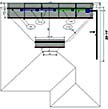![]()
(How this all connects together)
Draw up plans and specify system
side view with sun angle
top view, panels
top view, conduit

3.
Links to PGE
Email from PGE
Submit for Rebate to
California Energy Commission (Links)

 Wire map
Wire map
(How to wire 4 panels together)
We are now looking at how to efficiently balance the load between the amount of energy that the panels create and the rate in which PGE will credit us for this energy. We will receive the highest credit rate from PGE between noon and 6 pm, this is because the Utility meter tracts "time of usage."
This way we can take advantage of PGE rates being lower from 6 PM to noon, which is the time we consume most of our power. From noon to 6 PM the rates are higher and this is the time we generate the most energy.
We probably should change the time of day that we use large appliances (hot tub, clothes washer, dishwasher) so that they run the morning before noon.
PGE will send us a yearly statement.
- Compact florescent lighting
- florescent lighting
- turn off computers
- check for appliances (devices) that consume power in the "off"
position, use switched powerstrips to stop Phantom power.
- Computer
- Printer
- TV
- VCR
- Microwave oven